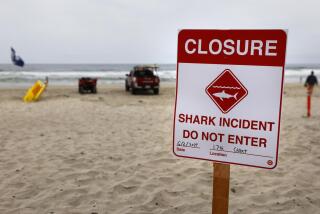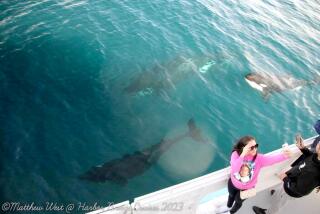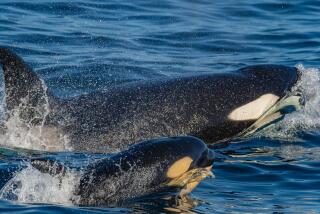Get Wahoo Before They Get You
SAN JOSE DEL CABO, Mexico — One angler said the fish he had caught shot out of the water like a missile before crashing down violently on the small, unsuspecting fish he was using for bait.
Another said the fish he had not caught attacked his bait so viciously and swiftly that he had no chance to set the hook.
Indeed, only slightly more than half of those who set out for a day’s fishing recently from the sun-baked stretch of beach east of San Jose were able to land the fish they were trying to catch.
Which can mean only one thing: Wahoo season is under way.
Violent strikes, sizzling runs, burning thumbs . . . these are fast and crazy times in the Sea of Cortez.
Everyone seems to be after the elusive wahoo.
David Viar, 30, a Santa Ana firefighter, has been coming down every fall since he was a child. He brought 14 other firefighter down this time because he wanted them to learn what a wahoo bite is all about.
“And we’re doing very well,” Viar said. “On the first day I caught two wahoo and two dorado.”
Rick Sakurai, a Los Angeles firefighter on his honeymoon, wanted to catch one so badly he talked his bride into letting him go fishing one day. He returned with two wahoo and four tuna.
Tomas Cantor, beach manager for the La Playita Fleet, a small panga fleet that fishes the nearby Gordo Banks, said that although marlin, tuna and dorado fishermen make up much of his clientele, wahoo fishermen flock to the region when the fish migrate into the gulf every fall.
Why?
“Because there’s no bigger thrill in fishing than there is catching a wahoo,” said Bill Sorenson, 81, a former Los Angeles theater manager who retired here in the early 1970s. “They’re so fast and unpredictable, you never know what they’re going to do.”
A sleek and slender relative of the tuna, the wahoo reaches weights well in more than 100 pounds and attacks its prey at speeds up to 60 m.p.h.
Spearfisherman Terry Maas, in his recently published book, “Bluewater Hunting and Freediving,” once witnessed a wahoo attack on a school of two-pound baitfish while on a diving trip to the Revillagigedo Islands off the west coast of Mexico.
“Drifting over a school of about 100 fish near a Mexican pinnacle, I saw a silver streak hit the center of the grouped fish,” Maas wrote. “The wahoo’s charge was accompanied by the sounds of water cavitation noise, much like the sound a motorboat makes, and ended in a loud ‘Whack!’ as baitfish scattered in all directions.
“One unlucky baitfish remained, cut in half by the wahoo’s incredibly sharp teeth. The great fish made a leisurely return, taking its meal in two gulps, and as so often happens in the ocean, the baitfish re-schooled, feverishly consuming the remaining bits of their brother.”
So sharp are the teeth and so powerful are the jaws of the wahoo that it can easily bite through the heaviest monofilament fishing line.
Those who fish for them with live bait--some prefer the less challenging method of trolling large lures--find that even with a wire leader, hooking a wahoo is no easy task.
Its mouth is so bony and hard that setting the hook before the fish steals the bait requires perfect timing by the angler and the skipper, who tries to gun the engine on the skiff the instant the fish strikes to help drive the hook into its mouth.
If that works, and it does only about half the time, the wahoo goes berserk. It sprints off so fast that the inexperienced angler sometimes panics, and tries to stop the run by pressing a thumb on the spool, which results in a painful burn.
Sorenson, who first visited this region in the early 1960s, helped transform La Playita’s commercial fishing fleet into a sportfishing fleet by bringing customers down from the United States.
He recently published an autobiography entitled “Siempre Manana” (Always Tomorrow), in which he profiles the San Jose area and its people.
One of them, a commercial fisherman, set out alone one day to try to catch some wahoo.
“This was proven to be unwise,” Sorenson wrote. “He had landed four fish with his hand line [hand lines are still popular among commercial fishermen] and was fighting a fifth. He regained consciousness some time later with the wahoo, his tackle and eight of his front teeth missing.”
A similar incident occurred off Cabo San Lucas. A large wahoo bolted out of the blue sea, chasing a lure being retrieved, and scored a direct hit on the fisherman. Its teeth tore the man’s arm open so badly that he had to be flown to a hospital in the United States.
In his book, Sorenson offers this advice:
“If you are making a fast retrieve of a jig while fishing wahoo, always stop your lure under the surface of the water. I have had wahoo jump in the boat with me but no harm [was] done.”
At the Revillagigedos years ago, a large wahoo charging after a lure being reeled sailed over the rail of a San Diego long-range boat with such speed it flew through the portal into the galley and landed on the dinner table.
Fitting, considering that the flesh of the wahoo is regarded as a delicacy by villagers and visitors alike, prized even over tuna and dorado.
Trouble is, catching one isn’t nearly as easy. And although it could happen, one cannot count on a wahoo landing in their lap.
MORE FISH STORIES
Sharing a piece of smoked wahoo at the cleaning tables, awaiting the return of the pangas , Cantor talked about some of the other interesting catches he has seen in his 12 years as manager of the La Playita fleet.
He told of dorado coming in some days at an average of 70-80 pounds, of wahoo tipping the beach scale at more than 100 pounds, of a 209-pound yellowfin tuna caught last July.
Then he got onto the subject of billfish--notably blue and black marlin.
He pointed to Viar, who holds the fleet record for blue marlin, an 810-pounder that was missing its bill.
Seven hours into the fight, Viar’s hands started to bleed.
After eight hours “he kind of went belly up on us,” Viar said. “Another panga came out and we threw a piece of rope around [the fish] and towed it in. It was too big for the boat, man.”
But it wasn’t as big as the 993-pound black marlin caught recently after a battle that lasted well into the night.
Cantor said the giant billfish inhaled two baited hooks, one with a five-pound yellowfin and the other with a skipjack.
“It’s the truth,” he said, sensing disbelief among his listeners. “But after four hours, the first pole broke and they kept up the battle with one. It was hooked at 2 p.m. and they got back here at 1:30 a.m.”
NOT SO STORMIN’ NORMAN
Retired Gen. H. Norman Schwarzkopf, interviewed by Sports Afield magazine, explained what about hunting keeps him returning to the field:
“Hunting, to me, is not the kill. Hunting is a wet bird dog leaning up against you in the blind to steal your warmth; and sitting around the campfire. . . . Hunting is the companionship.”
NATURE’S WAY . . .
An Oregon woman will probably think twice before trying to feed another wild animal. According to a report in the Contra Costa Times, Mary Stodley, 63, was hospitalized after trying to feed apple slices to a deer that had wandered into her campground. The buck attacked and Stodley suffered a broken tail bone and a severe cut to her right ear. . . . In the small Missouri town of Mexico, meanwhile, residents are up in arms--some literally--over an invasion of about 30,000 starlings, which are feeding in the nearby grainfields during the day and roosting--and relieving themselves--in the trees around the village square at sunset. According to a report in the San Francisco Chronicle, the birds have created more than a mere health hazard. “People won’t walk on the sidewalks, and the park benches are covered with [droppings],” City Manager Tom Parrott said. Some residents have had to have their cars repainted, and some insist they will start shooting if the city’s plan to trim the trees fails to dislodge the pesky birds.
CATCH OF THE WEEK
Locally: a 45-pound yellowtail by Brian Hunnec of Huntington Beach, at the Cortez Bank aboard the Pacifica out of L.A. Harbor Sportfishing. The boat returned Sunday with 49 yellowtail and limits of rockfish.
Baja: 73 striped marlin caught and released in eight days by Doug Daniel and two friends from Orange County aboard the private yacht Pescador. According to John Doughty of J.D.’s Big Game Tackle on Balboa Island, private boaters have reported massive schools of stripers on the west coast of the peninsula roughly 250 miles north of Cabo San Lucas.
More to Read
Sign up for The Wild
We’ll help you find the best places to hike, bike and run, as well as the perfect silent spots for meditation and yoga.
You may occasionally receive promotional content from the Los Angeles Times.





